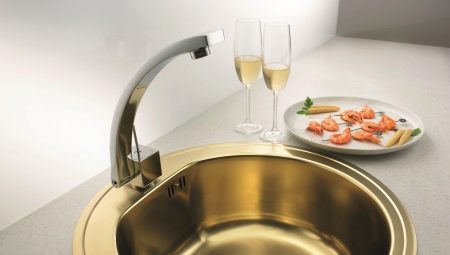In the process of repairing the kitchen, everyone is faced with the problem of choosing convenient, and most importantly, high-quality kitchen furniture and accessories. There are a lot of selection criteria - room size, interior style, necessary level of functionality, more. One of these items is a sink, and before buying, you should determine in advance the type of sink, size and material of which it is made. Today, specialized stores provide customers with a wide range of sinks - from economy to luxury. Therefore, everyone will be able to choose for themselves an option that meets all the stated criteria.
In the kitchen plumbing market, there are two types of sinks - overhead and mortise. The first for installation requires a separate countertop or cabinet on which it is mounted. It is mounted on the surface with its edges, therefore, to install this type of sink, you can do it yourself. Mortise sinks are mounted on the kitchen surface, in which the armhole necessary for it is cut out.
It is important to seal the junction of the countertop and sink well. Recently, it is mortise sinks that are gaining popularity, which are not only more aesthetic, but also do not require a separate worktop for installation.
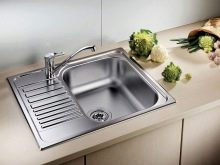
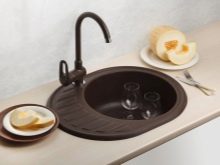
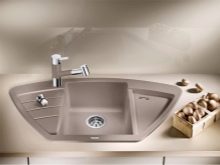
Features
Despite the fact that many modern housewives have already acquired such a kitchen assistant as a dishwasher, the need for a sink in the kitchen has not disappeared. Yes, the dishwashing process is much easier, but no one canceled washing hands during cooking, as well as various foods - vegetables, fruits, cereals and meat.Every time going to the bathroom for this is not an option. Today, the choice of a sink is just as important in setting up a kitchen as buying a stove or refrigerator.

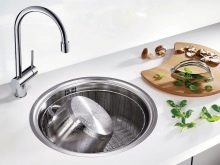
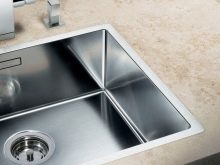
The convenience of mortise sinks makes them increasingly popular among kitchen sinks. Such products have several advantages that determine the choice of customers:
- aesthetic appearance is suitable for any kitchen interior;
- most sinks are made of high-strength metal, which makes them more wear-resistant;
- small sizes of sinks allow you to save more working space on the kitchen worktop;
- the strength of the material from which the mortise shells are made makes it possible to make them of various shapes - oval, square, round and others;
- mortise sinks are resistant to force, so they will last much longer overhead.
The only drawback is the rather problematic installation of the mortise sink in the countertop, which most often requires the help of specialists in this field.
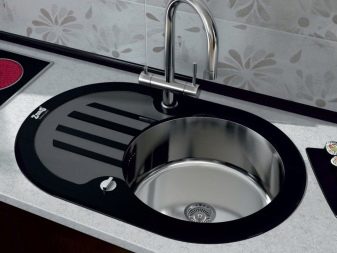
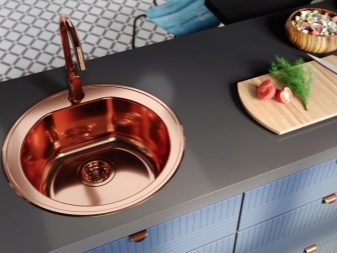
Materials
Today, a large number of various materials are used for the production of sinks.
- Ceramic sinks - refractory material makes the product quite strong and durable. They also have an attractive appearance and fit well into any style of cuisine. The disadvantage is the high cost.


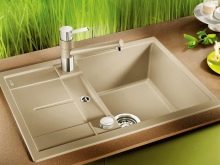
- Stainless steel sinks - such metal products are the most popular, as they combine an attractive price and good quality. Steel sinks well tolerate temperature jumps, mechanical stresses, and the life of such a product is almost unlimited. To clean them, you can use any detergents and cleaners. The only drawback is that they are quite noisy, and to reduce the noise level, you should choose sinks with dense walls.
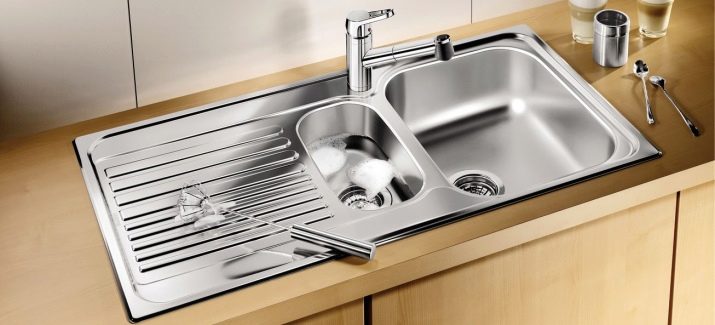
- Bronze or copper sinks. Such products do not tolerate forceful effects, since these materials are naturally soft. During operation, they are easily scratched and oxidized. To avoid this, a protective layer is applied to the surface. Such a sink looks stylish in any interior, but it is rather problematic to use, so before you buy it, you should think carefully.
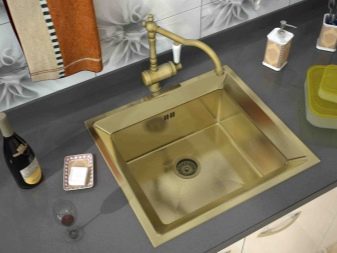
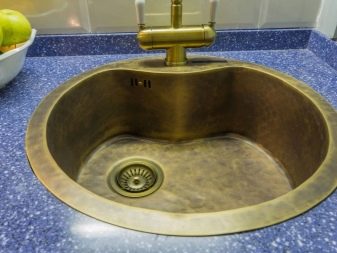
- Sinks made of natural stone - look rich, but impractical to operate. They have a large mass, poorly tolerate temperature jumps and contact with food dyes.
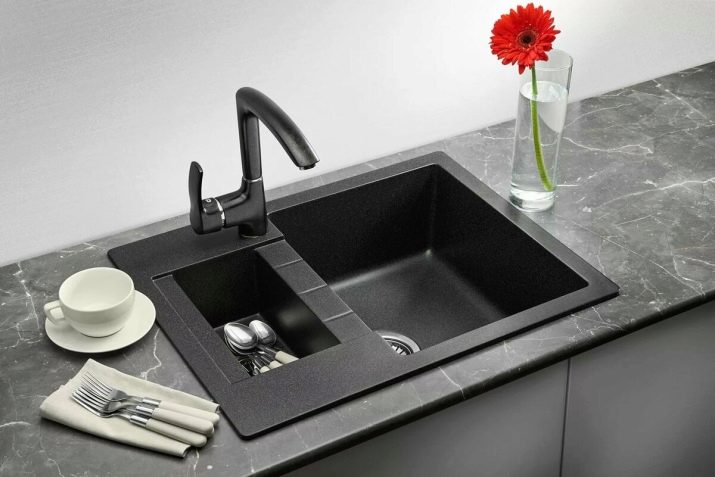
- Composite Sinks - have a fairly large mass and are highly durable. Sinks from this material can have a variety of colors and shapes. They are almost noiseless and tolerate temperature changes, as well as force effects. Pretty easy to care for.
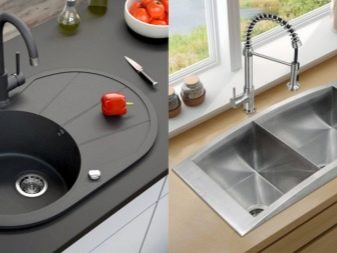
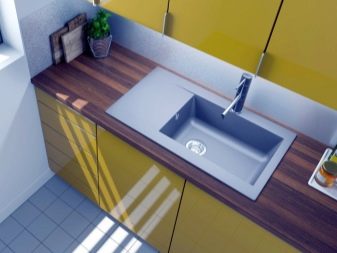
Shapes and sizes
In specialized stores you can find sinks of various shapes and sizes. The bowl of such shells may have the shape of a circle, oval, square, rectangle. Which form to choose depends only on the buyers, as it should not only fit the room’s interior well, but also be practical to use.
Size is of no small importance as is the depth of the product. The optimal washing depth is 20-25 cm, if it is small - water when washing dishes may splash outside the sink. A deep sink may be inconvenient for its exploitation by children, as well as by people of short stature.
The diameter of the sink is best chosen based on the size of the kitchen surface as a whole. For small kitchens, sinks measuring 35 cm, 38x38 cm, 40 cm, 40x40 cm are suitable.
If the kitchen space allows, then you can choose products with dimensions of 50x60 cm, 50 cm, 50x50 cm, 60x60 cm. You should also take into account the approximate amount of dirty dishes and the size of the largest pan used in cooking. If small dishes can still be placed next to the sink and washed in turn, then a large pot will need to be placed and washed somehow, so as not to do this in the bathroom.
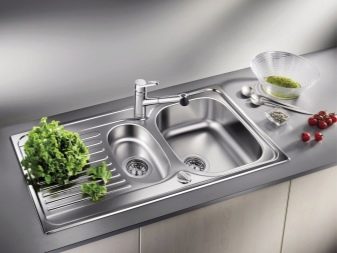
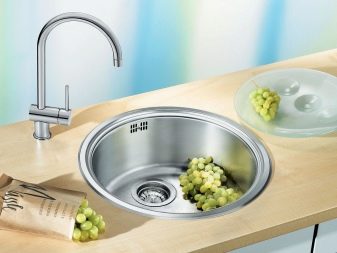
Design options
Mortise kitchen sink is an equally important component of kitchen design. It not only helps to work comfortably in the kitchen, but is also part of the interior. The materials from which sinks are made allow them to be made in a wide variety of shapes, sizes, and colors. In addition to the standard metallic color, you can find products of the color of natural stone, beige, white, black and other colors.
The most popular are metallic and white, as they will fit almost any style. The black sink looks very stylish in a kitchen made in a modern design - hi-tech, minimalism, techno.
In addition to standard sinks, there are products with optional accessories: double bowl, chopping board, wings, waste chopper, detergent container and sponges.
All these additions make using the sink even more practical and comfortable. However, the cost of such a model will be an order of magnitude higher than conventional products.
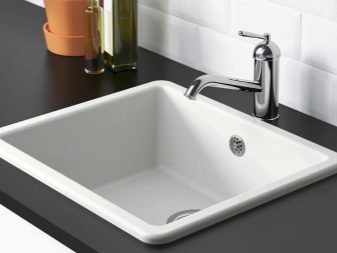
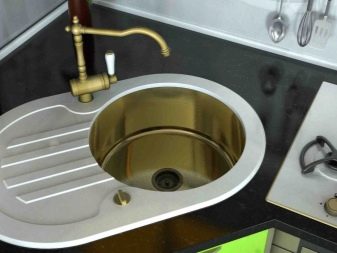
How to choose?
Before you start buying a sink, you need to consider several important points that will help you make the right choice.
First you need to choose the material from which the sink will be made. Enamelled steel products are an economic option, however, if used improperly, one may encounter the problem of cracks and chips on the surface of the sink. Enamelled cast iron sinks - the cost is higher than the previous option, but its disadvantages do not disappear. The only plus - thanks to the thick walls, the sound of water is almost inaudible.
Natural stone sinks are also impractical to use.
The advantage is that the scratches that appear can be easily sanded, however, intolerance to high temperatures (over 150 degrees) is a huge disadvantage of such products. Since putting a hot pot in such a sink, you can permanently ruin its surface.
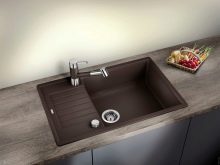
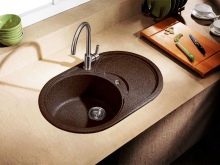
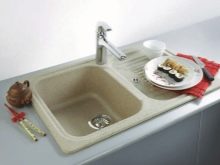
Ceramic products are well tolerated by sudden changes in temperature, and they are not scratched, and their life is almost unlimited.
The best option is a stainless steel sink. With its advantages, it does not lose to ceramic sinks. Plus, the cost of such a sink is low and meets all its characteristics.
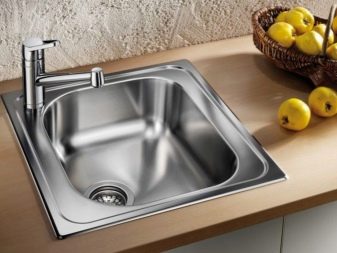

The next selection criterion is size. The optimal shell depth is considered to be 20-25 cm. The width depends on the total size of the entire working surface of the kitchen. If it is quite large, then the size of the sink can be about 60x50 cm. But for a small kitchen, a sink with a diameter of 35-40 cm will be the best option.
Overflow is required. The size of its grate should be quite large so that excess water can easily go away.
The presence of the wings allows you to set the dishes so that water drains, as well as hot pots and pans. But it’s important to consider that a sink with wings takes up a lot more work space than a conventional sink.
If the working space of the countertop allows, you can pick up a sink, consisting of several compartments. In an additional bowl, you can soak the dishes, rinse something, or just wash your hands if the main bowl is filled with unwashed dishes.

Subtleties of installation
Those who decide to mount the mortise sink themselves, you should know a few simple rules, that will help to do this without outside help.
- To begin with, you should mark the sink on the work surface by applying its upper part to the countertop where the sink will be installed.
- Then 1 cm back from the drawn markup and draw the second.
- Using a jigsaw, cut out the marked area on the second marking.
- After that, align the edges of the cutout, carefully cleaning them.
- Sealant is applied to the slices using a brush or spatula. The level of protection against water leakage through the gaps at the junction of the sink and surface depends on the correctness of its application.
- Then, a sealant is attached to the edges, excess edges are cut off.Often it comes in a set with a mortise sink.
- The last step is to install the sink, which with several fasteners (with the same distance from each other) is placed in the prepared hole.
Before mounting the sink along its edges you need to go through a file. All visible bumps on the countertop or sink must be sealed. Observing all of the above recommendations, you can independently install a mortise sink.
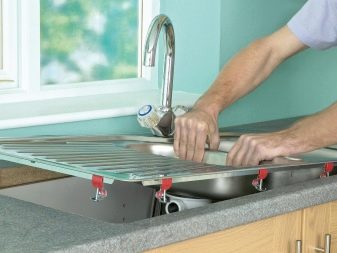
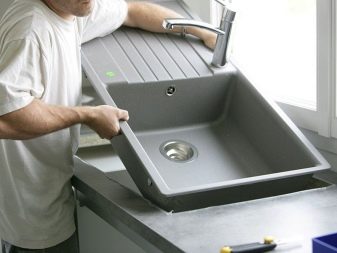
On how to embed a sink into the countertop with your own hands, see the next video.
